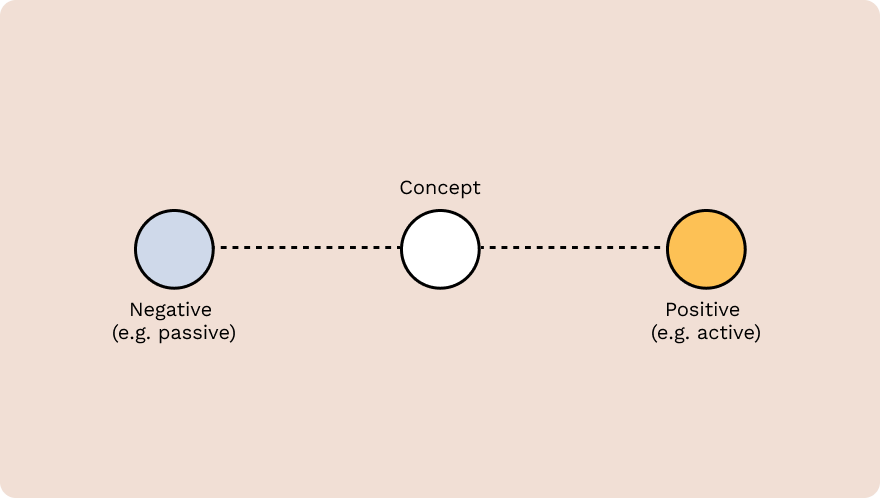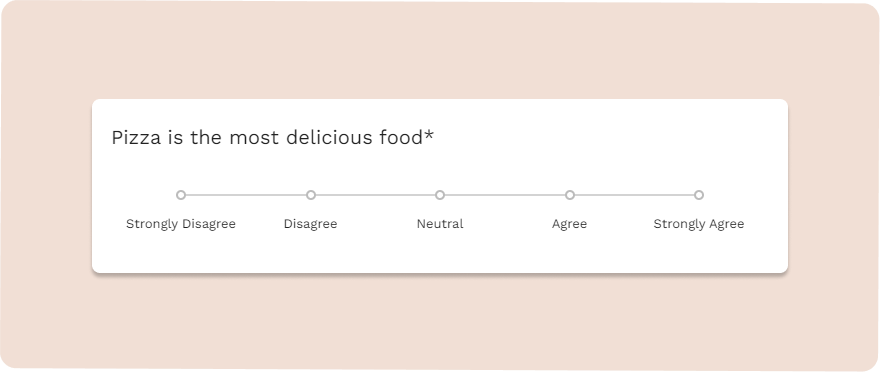
All Solutions

Explore all the solutions you can create with Paperform: surveys, quizzes, tests, payment forms, scheduling forms, and a whole lot more.
See all solutions











Connect with over 2,000 popular apps and software to improve productivity and automate workflows
See all integrationsProducts
Solutions
All Solutions

Explore all the solutions you can create with Paperform: surveys, quizzes, tests, payment forms, scheduling forms, and a whole lot more.
See all solutionsIntegrations

Connect with over 2,000 popular apps and software to improve productivity and automate workflows
See all integrationsResources
Semantic differential scales: A comprehensive guide

If you want to improve the quality of your company’s products or services (and who doesn’t?), it’s difficult to exaggerate how important it is to collect customer feedback.
Good customer feedback helps you improve your offerings, enhance team performance, grow brand loyalty and garner insights to make better business decisions in the future.
Customer satisfaction surveys are a great way to do this. The problem is the kind of information you get from basic surveys is limited—you need to take the time to think about what customer responses really mean and choose the right question types to maximize your data.
There's no better strategy for doing this than the semantic differential scale. In this post, we'll demystify the process so you can use the semantic differential technique like a pro and start reaping the rewards for your business.
What is a semantic differential scale?
When you Google the semantic differential scale, you’ll mostly find articles that read as if the writer ate a thesaurus for breakfast. If you collected all the five-dollar words you could fund an all-expenses-paid trip to Hawaii.
Why's this? Because the semantic differential scale has its origins in academia. And as the poet and author Charles Bukowski said, “an intellectual is someone who says a simple thing in a hard way.” So let’s try to cut to the chase.
The semantic differential scale is a survey rating tool that measures a person’s attitude towards something. It does so by asking respondents to make a judgement on a point-scale between two bipolar adjectives." For example, you could measure someone’s attitude towards their workplace culture with the scale below:
Why do we use semantic differential scales?
In the business world, this scale is used to ask people to rate an experience, product, idea or even a brand. It’s one of the most reliable ways to discover a person’s attitude towards, well, just about any topic you can think of.
The scale was developed in 1957 by Charles E. Osgood, a social psychologist who studied the field of psycholinguistics, a branch of cognitive science dealing with the mental aspects of speech and language.
In his research, Osgood discovered that across all cultures there are certain words and phrases that have negative or positive connotations. A connotation is an idea or feeling that a word invokes for a person outside of its literal meaning.
So while the word 'lion' refers to a large brownish-orange cat that lives in prides and is found in the African Savannah, its connotative meaning is bravery. In the same way, words like 'strong' and 'good' have positive connotations, while words like 'bad' and 'weak' have negative connotations.
While studying these connotations Osgood found there are three dimensions of 'affective meaning' that are universal across all cultures, regardless of language: evaluation (good-bad), potency (high-low) and activity (fast-slow).
Osgood realised that by using these antonyms (words with opposite meanings), you can understand a person’s emotional attitude towards just about anything. Voila, the semantic differential scale was born.
So how does it work? Well, you create questions with rating scales and ask respondents to give a judgement between two bipolar adjectives. Respondents then choose the point on the scale that best reflects their opinion.

The academic explanation for what the scale does is that it measures the connotative meanings of emotional attitudes toward specific objects so that it can be recorded. But that's a mouthful.
To put it in plain English, it helps you understand how people feel about a certain thing. This is great for two reasons:
- It lets you understand the value the respondent places on the topic and;
- It gives respondents an opportunity to show you how your product or service did or didn’t live up to their expectations
Now, what started as a technique for social ethnography (the study of people and cultures) has been adapted to many fields, from the social sciences and therapy to consumer research and video game development.
This technique has become useful for a variety of subjects for businesses. You can use semantic differential scale questions to ask respondents to rate products, services, user experiences, or your brand as a whole.
Hopefully we’ve managed to simplify these surveys for you, now let’s compare it to another survey type that you’ll have used before: the Likert scale.
What's the difference between Likert scales and semantic differential?
The chances are you've come across a Likert scale question when filling out a survey or questionnaire. Like semantic differential scale questions, it's a popular way to measure attitudes. It does so by asking respondents to express how much they agree or disagree with a predefined statement.
A question that uses the Likert scale looks like this:

Semantic differential scales and Likert scales are kind of like moths and butterflies. At first, they seem similar, but once you take a good look you realise they’re nothing alike.
Let’s deal with the similarities first. Both scales ask respondents to report on a certain element of their experience and feature a list of options presented on a rating scale. Both also share the goal of better understanding what customers like or don’t like about a product, idea, service or brand.
customer effort score survey
But there are two key differences:
- How the survey questions are asked
- What kind of information the researcher hopes to obtain from the responses.
Likert Scale vs a Semantic Differential: Differences
The main difference comes down to wording and perspective. Semantic differential questions are open-ended, where Likert scale questions aren't. Let's compare each scale to make the contrasts easier to spot.
1. The framing of the question
A Likert question gives you a concrete statement that you have to agree or disagree with.
In contrast, a semantic differential scale offers a more open-ended question that it’s up to you to complete based on your feelings.
With a semantic differential question, you can choose between the two contrasting words with options in between. There’s no need to ‘agree’ or ‘disagree’. If you don’t think the blog post is great, you can just skew your answer slightly to the left.
You’ll notice the Likert scale question starts with the assumption that ‘this blog post is good’. Intentionally or not, this uses the power of suggestion to plant the idea in your head that the blog post is, well, good.
Now imagine, instead, it says ‘this blog post is bad’. The question suddenly takes on an entirely different tone that can bias responses. The semantic differential scale provides bipolar adjectives that let you define the degree to which the blog post was great or terrible.
2. The semantic scale allows more autonomy
The second big difference: semantic differential scales allow users more autonomy to express unique opinions in their responses compared to Likert scale questions.
Where Likert scale questions are worded in a way that’s more restrictive and declarative, the bipolar adjectives of the semantic scale leave room for respondents to interpret questions in their own way and express their thoughts with more accuracy.
Take a look at this image of the New York skyline.

Take your time to inspect the ombre sunset and the soaring skyscrapers of the Big Apple. When you’re ready, answer this Likert scale question in your head:
Notice how this Likert question defines the photograph as beautiful? Rather than asking your opinion on whether you find the photo of New York beautiful or not, it asks you to agree or disagree with the statement that it is beautiful.
Now take a look at how this changes with the semantic differential scale.
Notice how it doesn’t add an outside opinion? It’s up to the respondent, to decide how you want to define the image within the bipolar scales. The choice is in your hands.
Semantic differential scale surveys help you get a more accurate idea of customers’ attitudes by trusting them to define their own unique values rather than holding their hands. This lets people describe their own attitudes, opinions and feelings and leads to more specific feedback.
Using this technique not only simplifies the measurement of attitudes, but it also allows you to collect data that's more honest and reliable (which means it’s more useful to your business).
Semantic differential scale: best practices
Semantic differential scale surveys are best suited for when you need to gain insight into your attitudes, needs or opinions, or to measure satisfaction.
But before you do any of that, you’ve got to create the survey. There are a few key rules to follow:
1. Stick to the three dimensions
It’s best to make sure your rating scales stick to one of the three dimensions:
- Evaluation
- Potency
- Activity
Charles Osgood spent years researching these things so you don’t have to—there’s no need to try and reinvent the wheel.
This ties in with the type of questions you ask. Semantic differential scale surveys need to be conducted with open-ended questions. These encourage more than a simple yes/no response and allow respondents to communicate their thoughts about the subject at hand.
2. Settle on the right bipolar adjectives
The hardest (and most important) part of creating your semantic differential survey is figuring out the right bipolar adjectives to use.
Finding the right antonyms is the key ingredient to success, so make sure you spend some time thinking about which words suit each question.
Ready To Start Measuring Your Customers' Attitudes?
Create a beautiful semantic differential scale survey with Paperform
Create a semantic differential scale with Paperform
We have a semantic differential template you can use if you don't feel like building one from scratch. Prefer to do it yourself? We've included a short tutorial below to get you up and running.
Step 1: Add a scale question
Create a blank form and add the ‘Scale’ question type from the dropdown menu. This is the option you want to pick whether you’re using a semantic differential scale or a Likert scale.
 (Image via Paperform)
(Image via Paperform)Type your question into the field. Remember to keep it simple and open-ended. Then click on the cogwheel to configure the question. Name your bipolar scales, and select how many points you want on your rating scale.
Step 2: Define the bipolar adjectives
It’s standard for semantic differential scale surveys to be on a five or seven-point scale. It's up to you whether you want to replace each number with a word or use a combination of both. When you're done it'll look something like this:
 (Image via Paperform)
(Image via Paperform)Make sure you keep the negative adjective on the left side of the scale and adjust the words you use to suit the question you’re asking. Repeat this process for each question.
Extra step: Customise your form
That's it! Once you’ve created your questions, you can customise your form to look just how you want it to look. Change fonts and colours and add images, videos and your brand logo to make it as unique as you are.
When you’re happy with your semantic differential scale survey, you can share a link to your self-hosted form with Paperform, embed it on your website, or share it via email. Then just sit back, kick your feet up, and wait for the responses to roll in.
Unlock new insights with semantic scales
Semantic differential scale surveys are one of the most powerful tools you can harness to understand your customer attitudes. They encourage you not to think of customers as bland numbers, but to discover their unique opinions, thoughts and ideas.
By collecting and analysing this data, you can gain unprecedented insights into what is and isn’t working within your business. Is that new product hitting the mark? Is your website easy to use? Is your in-store playlist giving the right vibe?
From shaping your ideal workplace culture to staying ahead of the curve with competitive pricing, the responses you receive will highlight strengths and weaknesses and ultimately help improve your business.
Don’t waste any more time wondering what your customers think or where you’re going wrong. Make a semantic differential scale survey today with Paperform's 14-day free trial—no credit card required.
FAQs
💡 Semantic Differential Scale FAQs:
What is an example of a semantic differential question?
Semantic differential scale questions ask respondents to mark their position on a scale between two opposite adjectives, such as "Good-Bad", "Hot-Cold", "Black-White."
What is the purpose of semantic differential scale?
The purpose of a semantic differentrial scale is to measure a person's attitude towards a particular concept. This can be anything, though businesses use it to discover customer attitudes towards an experience, product, idea or their brand.
How many adjectives are there in a semantic differential scale?
A semantic differential scale uses two bipolar adjectives, one negative adjective on the left of the scale, and one positive adjective on the right of the scale. For example, Bad (left) and Good (right).
What's the difference between Likert scale and semantic differential?
A Likert scale question asks you to agree or disagree with a complete statement, while a semantic differential scale question asks you to complete the statement yourself, using the two opposite adjectives as guidelines on a pre-defined scale.
Form a better life now.
Get your 7 day unrestricted trialHere is the ultimate list of online form builders, what they do best, their pricing, and examples to...
Independent retailers are some of the smartest operators in small business—but they’re forced to wor...
Independent retailers are some of the smartest operators in small business—but they’re forced to wor...
The ultimate list of Black Friday and Cyber Monday SaaS deals for 2025